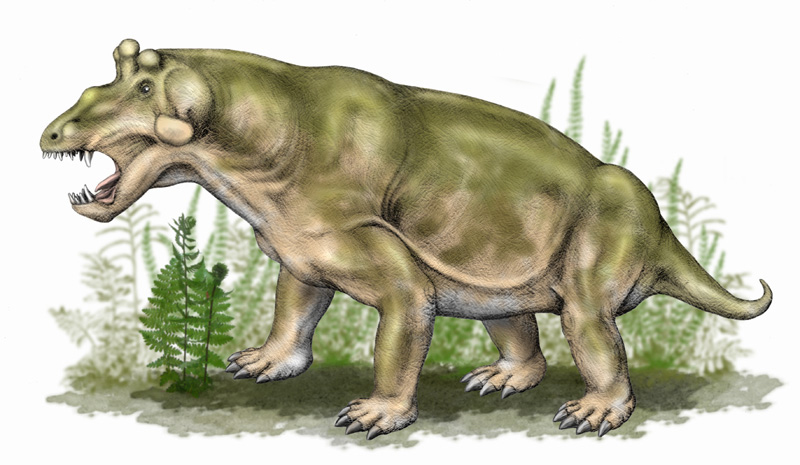Estemmenosuchus on:
[Wikipedia]
[Google]
[Amazon]
''Estemmenosuchus'' (meaning "crowned crocodile" in Greek) is an
 ''Estemmenosuchus'' is interpreted to have lived some 267 million years ago. Two species have been identified, from the
''Estemmenosuchus'' is interpreted to have lived some 267 million years ago. Two species have been identified, from the

Palaeos
- detailed description {{Taxonbar, from=Q133120 Tapinocephalians Prehistoric therapsid genera Wordian genera Guadalupian synapsids of Europe Permian Russia Fossils of Russia Fossil taxa described in 1960
extinct
Extinction is the termination of a kind of organism or of a group of kinds (taxon), usually a species. The moment of extinction is generally considered to be the death of the last individual of the species, although the capacity to breed and ...
genus of large, early omnivorous therapsid. It is believed and interpreted to have lived during the middle part of the Middle Permian around 267 million years ago. The two species, ''E. uralensis'' and ''E. mirabilis'', are characterised by distinctive horn-like structures, which were probably used for intra-specific display. Both species of ''Estemmenosuchus'' are from the Perm (or Cis-Urals) region of Russia. Two other estemmenosuchids, ''Anoplosuchus'' and ''Zopherosuchus'', are now considered females of the species ''E. uralensis''. There were many complete and incomplete skeleton
A skeleton is the structural frame that supports the body of an animal. There are several types of skeletons, including the exoskeleton, which is the stable outer shell of an organism, the endoskeleton, which forms the support structure inside ...
s found together.
Description
''Estemmenosuchus'' could reach a body length of more than . Its skull was long and massive, up to in length, and possessed several sets of large horns, somewhat similar to the antlers of a moose, growing upward and outward from the sides and top of the head. The animal had a sprawling posture as indicated by analysing its shoulder joints. The skull superficially resembles that of ''Styracocephalus
''Styracocephalus platyrhynchus'' ('spike head') is an extinct species of tapinocephalian therapsids that lived during the Guadalupian epoch.
''Styracocephalus''s head ornament meant that it could be recognised from a distance. The most striki ...
'', but the "horns" are formed from different bones; in ''Estemmenosuchus'' the horns are located on the frontals and protrude upward, whereas in Styracocephalus the horns are formed by the tabular and extend aft.
Species
 ''Estemmenosuchus'' is interpreted to have lived some 267 million years ago. Two species have been identified, from the
''Estemmenosuchus'' is interpreted to have lived some 267 million years ago. Two species have been identified, from the Ocher Assemblage Zone
Ochre ( ; , ), or ocher in American English, is a natural clay earth pigment, a mixture of ferric oxide and varying amounts of clay and sand. It ranges in colour from yellow to deep orange or brown. It is also the name of the colours produced ...
Belebei Formation
Belebey (russian: Белебе́й; ba, Бәләбәй) is a town in the Republic of Bashkortostan, Russia, located on the bank of the Usen River, from Ufa. Population:
History
Belebey was established in 1715 and granted town status in 1781. ...
at the Ezhovo locality near Ochyor
Ochyor (russian: Очёр), alternatively spelled Ocher, is a town and the administrative center of Ochyorsky District in Perm Krai, Russia, located on the Ochyor River (Kama's tributary), west of Perm, the administrative center of the krai. Po ...
in the Perm region of the Russia in 1960. They were found with the Biarmosuchians ''Eotitanosuchus olsoni
''Eotitanosuchus'' ("dawn giant crocodile") is an extinct genus of biarmosuchian therapsids whose fossils were found in the town of Ochyor in Perm Krai, Russia. It lived about 267 million years ago. The only species is ''Eotitanosuchus olsoni''. ...
'' and '' Biarmosuchus tener'' in channel flood deposits of the young Ural Mountains. They differ in size, shape of the skull, and shape of the horns.
Originally all specimens were included in ''Estemmenosuchus uralensis'', but it was since realised that there were a number of different species. However, not all palaeontologists agree that these were different species. According to Ivakhnenko (1998) ''Anoplosuchus'' and ''Zopherosuchus'' are synonyms of ''Estemmenosuchus uralensis''.
Paleobiology

Thermoregulation
It has been suggested that the animal had a fairly constant internal temperature. Its large size and compact build gave a small surface-to-volume ratio and suggests it would not gain (or lose) temperature quickly. This phenomenon is called gigantothermy and was probably an important factor in temperature regulation in most therapsids.Skin
P. Chudinov reported skin impressions belonging to ''Estemmenosuchus'' in 1968. The skin was described as being "gland
In animals, a gland is a group of cells in an animal's body that synthesizes substances (such as hormones) for release into the bloodstream (endocrine gland) or into cavities inside the body or its outer surface (exocrine gland).
Structure
De ...
ular" like that of a hairless mammal or a frog.
References
Further reading
* Chudinov, P. K. 1965, "New Facts about the Fauna of the Upper Permian of the USSR", '' Journal of Geology'', 73:117-30 * King, Gillian M., "Anomodontia" Part 17 C, '' Encyclopedia of Paleoherpetology'', Gutsav Fischer Verlag, Stuttgart and New York, 1988 * Olsen, E. C., 1962, Late Permian terrestrial vertebrates, USA and USSR '' Transactions of the American Philosophical Society'', new series, 52:1–224 *Patricia Vickers-Rich
Patricia Arlene Vickers-Rich (born 11 July 1944), also known as Patricia Rich, is an Australian Professor of Palaeontology and Palaeobiology, who researches the environmental changes that have impacted Australia (including the ancient super c ...
and Thomas H. Rich
Thomas may refer to:
People
* List of people with given name Thomas
* Thomas (name)
* Thomas (surname)
* Saint Thomas (disambiguation)
* Thomas Aquinas (1225–1274) Italian Dominican friar, philosopher, and Doctor of the Church
* Thomas the Ap ...
, The Great Russian Dinosaurs, Guntar Graphics, 1993, p. 30
External links
Palaeos
- detailed description {{Taxonbar, from=Q133120 Tapinocephalians Prehistoric therapsid genera Wordian genera Guadalupian synapsids of Europe Permian Russia Fossils of Russia Fossil taxa described in 1960